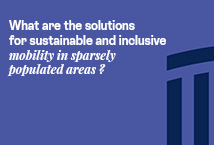- Home
- ESEC SCOPE
- Publications
- What are the solutions for sustainable and inclusive mobility in sparsely populated areas ?
What are the solutions for sustainable and inclusive mobility in sparsely populated areas ?
Visuel

Type of text :
Opinion
Type of referral :
Own initiative
Working group :
TERRITORIES, AGRILCULTURE AND FOOD COMMISSION
Date d'adoption
Date adopted : 07/11/2023
Mandature
2021-2026
Rapporteur(s) :
Photo

Sébastien MARIANI
Overview
Présentation
Most of us must travel every day, whether it’s to buy food, go to work or keep a doctor’s appointment. In sparsely populated areas, a car is often the only solution. Dependence on a car can be accompanied by economic and social inequalities. Not everyone can afford or has the ability to drive one. Climate change is another issue, given the impact of fossil fuels.
Meeting the challenges of mobility in sparsely populated areas
Developing sustainable and inclusive mobility in sparsely populated areas is both an undeniable necessity and an ambitious challenge. The development of alternative solutions, a real, necessary transition, requires changing mind sets and investing substantial financial resources to meet people's expectations.
To achieve these goals, the EESC has drawn up a set of recommendations that are the result of a major public participation process designed to ensure that the expectations and needs of the people living in the areas concerned are heard.
The recommendations, which focus on three areas, aim to:
→ Bring together the conditions for a successful transition to more energy-efficient transport;
→ Favour the inter-municipal level and inclusive governance involving citizen participation;
→ Enhance the appeal of sparsely populated areas through public transport.
These recommendations require a major new policy and programming law and an overhaul of the tax system to restore local authorities’ empowerment.